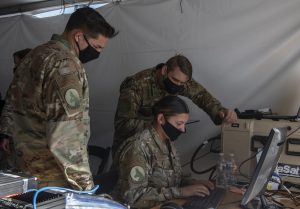The Pentagon’s Joint All Domain Command and Control (JADC2) strategy is likely to be approved by Defense Secretary Lloyd Austin within a few weeks and has already been signed off by the chairman of the Joint Chiefs of Staff, a lead official said Tuesday.
Army Brig. Gen. Rob Parker, the J-6 deputy director, said the new version of the JADC2 reference architecture that will establish the framework for passing data across future capabilities is also being sent over to the Joint Requirements Oversight Council for final endorsement.

“We have the full support moving ahead with [the JADC2 strategy],” Parker said during an AFCEA DC discussion. “[The reference architecture] is informed by a lot of work that’s been done in conjunction with the DoD chief data officer and other stakeholders to really get the right framework for where we need to go with our focus on data, which we really believe is essential to bringing about the desired JADC2 environment that we need.”
JADC2 is the department-wide effort to build a cross-service digital architecture for multi-domain operations, with Parker noting the strategy is currently being reviewed by Deputy Defense Secretary Kathleen Hicks.
Marine Corps Lt. Gen Dennis Crall, the joint staff’s chief information officer, said the department will release an unclassified version of the JADC2 strategy while keeping details on the nuclear command and control aspect of the effort classified (Defense Daily, April 21).
Parker said the JADC2 Cross-Functional Team is now working on staffing up to implement the strategy, which will include converging elements from each of the military service and combatant efforts working on individual components of the architecture.
“There we’ll see very clear objectives, tasks, plans of actions and milestones. From that, we’re reaching out to the services from their contributing efforts, both Project Convergence for the Army, ABMS for the Air Force and Project Overmatch for the Navy. But we’re not just looking at the services, we’ve also gone out to the combatant commands for things like NORTHCOM’s Global Information Dominance exercises,” Parker said.
Speaking on an Army-focused panel, Parker specifically highlighted the service’s contribution from Project Convergence to JADC2 beyond the effort’s advancements in shortening the sensor-to-shooter timeline.
“When we look at Project Convergence, we see their efforts coming up this fall looking at things like contested logistics, unmanned aerial delivery, leader-follower vehicles. It’s not just the technology, but also looking at what kind of network needs to be built to support those and does that data move both to and from the sensors and devices to really help build that ability to sense, make sense and act across the force,” Parker said.